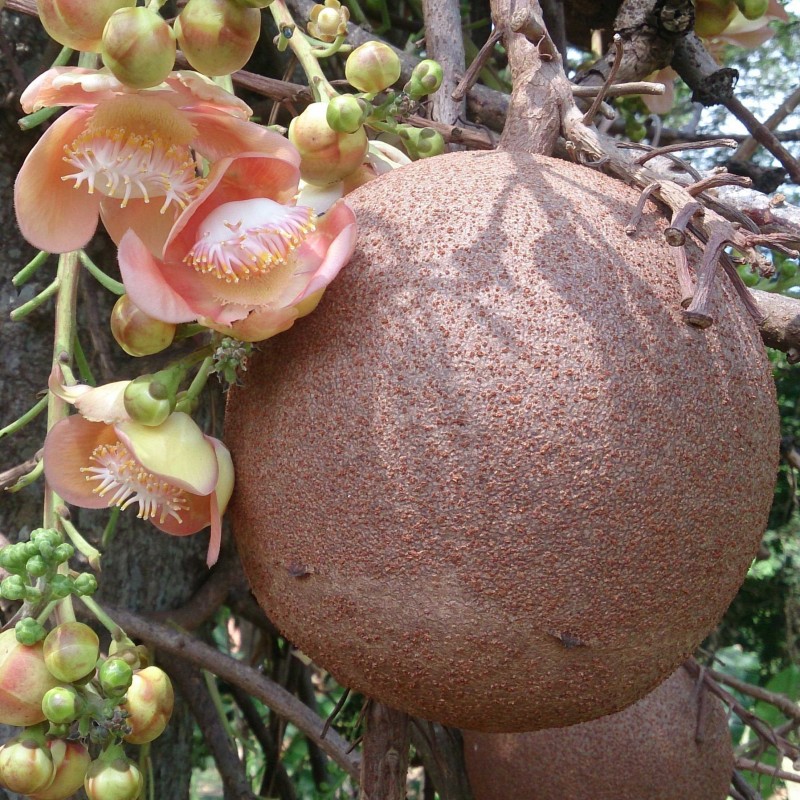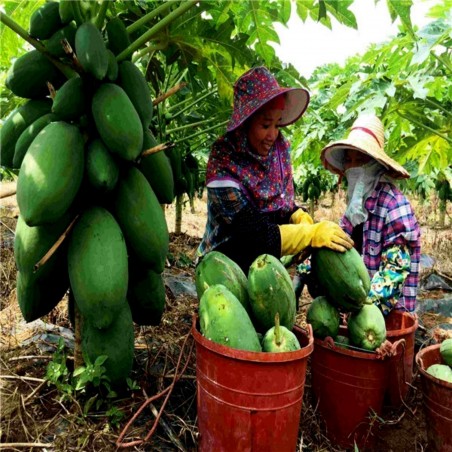
Cannonball Tree Seeds (Couroupita guianensis)
Cannonball Tree Seeds (Couroupita guianensis)
Price for Package of 3 seeds.
Couroupita guianensis, known by a variety of common names including cannonball tree, is a deciduous tree in the family Lecythidaceae, which also includes the Brazil nut (Bertholletia excelsa) and Paradise nut
Cannonball Tree Seeds (Couroupita guianensis)
Price for Package of 3 seeds.
Couroupita guianensis, known by a variety of common names including cannonball tree,[2] is a deciduous tree in the family Lecythidaceae, which also includes the Brazil nut (Bertholletia excelsa) and Paradise nut Lecythis zabucajo. It is native to the rainforests of Central and South America,[3] and it is cultivated in many other tropical areas throughout the world because of its beautiful, fragrant flowers and large, interesting fruits.[4] There are medicinal uses for many parts of Couroupita guianensis,[5] and the tree has cultural and religious significance in India,[5] Sri Lanka, and Southeast Asia.
Couroupita guianensis is a tree that reaches heights of up to 35 metres (110 ft). The leaves, which occur in clusters at the ends of branches, are usually 8 to 31 centimeters (3 to 12 inches) long, but can reach lengths of up to 57 centimeters (22 inches).[7] The flowers are born in racemes up to 80 centimeters (31 inches) long. Some trees flower profusely until the entire trunk is covered with racemes. One tree can hold as many as 1000 flowers per day. The flowers are strongly scented, and are especially fragrant at night[8] and in the early morning.[7] They are up to 6 centimeters (2.5 inches) in diameter, with six petals, and are typically brightly colored, with the petals ranging from shades of pink and red near the bases to yellowish toward the tips. There are two areas of stamens: a ring of stamens at the center, and an arrangement of stamens that have been modified into a hood.[7] The fruits are spherical with a woody shell and reach diameters of up to 25 centimeters (10 inches), which give the species the common name "cannonball tree". Smaller fruits may contain about 65 seeds, while large ones can hold as many as 550.[7] One tree can bear 150 fruits. The fruits take up to a year to mature in most areas, sometimes as long as 18 months.
Scientific and common names
The tree was named Couroupita guianensis by the French botanist Jean Baptiste Christophore Fusée Aublet in 1755. Common names in other languages include many translations of the English cannonball tree. Common names include macacarecuia (Portuguese), coco sachapura (Colombia, Panama), bala de cañón (Costa Rica, Panama), kanonskogelboom (Dutch), arbre à boulet de canon (French), kouroupitoumou (French Guiana), nagkeshar (Bengali), Nagalinga Pushpa (Kannada), Nagalingam or Lingam (Tamil), నాగమల్లి Nagamalli (Telugu), sala (Indonesia), granadillo de las huacas (Panama), ayahuma (Peru), and boskalebas (Suriname).[9] It is also called Naaga danthee in Malayalam and Nagakeshara ନାଗକେଶର in Odia.
Pollination
Although the flowers lack nectar, they are very attractive to bees, which come for the pollen. The flowers produce two types of pollen: fertile pollen from the ring stamens, and sterile pollen from the hood structure. The pollinators must work their way between the two areas of stamens as they gather the pollen. The carpenter bee Xylocopa brasilianorum is a common pollinator of cultivated trees in Rio de Janeiro, just outside the tree's native range. Other carpenter bees such as Xylocopa frontalis, as well as wasps, flower flies, and bumblebees, are also known visit the flowers.
Dispersal
The seeds are dispersed by animals that feed on the fruits. When the fruits fall to the ground, the hard, woody shell usually cracks open, exposing the pulp and seeds. Fruits that remain whole may be broken open by animals such as pecarries. Many animals feed on the pulp and seeds, including peccaries, the paca, and domestic chickens and pigs. The seeds are covered with trichomes which may protect them as they pass through the animals' digestive systems.
Human uses
Couroupita guianensis is planted as an ornamental for its showy, scented flowers, and as a botanical specimen for its interesting fruit.
The fruit is edible, but is not usually eaten by people because it can have an unpleasant smell.[9] It is fed to livestock such as pigs and domestic fowl.
There are many medicinal uses for the plant. Native Amazonians use extracts of several parts of the tree to treat hypertension, tumors, pain, and inflammation. It has been used to treat the common cold, stomachache, skin conditions and wounds, malaria, and toothache.[5] The fruit pulp is rubbed on sick dogs to cure them of mange.[10] Laboratory tests show that extracts of the plant have some antimicrobial activity and inhibit the formation of biofilms
Cultural significance
In India, the tree is sacred to Hindus, who believe its hooded flowers look like the nāga, and it is grown at Shiva temples.
According to Buddhist tradition, Maya held onto the branch of a blossoming sal tree (Shorea robusta) while she was giving birth to the Lord Buddha. Because of this, the sal tree is revered by many Buddhist people around the world. For reasons that remain unclear, after C. guianensis was introduced from Guyana to a botanical garden in Sri Lanka in 1881, the tree was mistakenly believed to be Shorea robusta and has been planted around many Buddhist temples in Sri Lanka and Southeast Asia.
| HEIRLOOM ? | Yes |
|---|---|
| Organic Seeds ? | Organic Seeds |
| Edible ? | Edible |
| Perennial ? | Perennial plant : Yes |
| Handgeplukte zaden? | Handgeplukte zaden |
| Suitable for growing in flower pot ? | Suitable for pot: Yes |


Uw beoordelingswaardering kan niet worden verzonden
Rapporteer reactie
Melding verzonden
Uw opmerking kan niet worden verzonden
Schrijf uw recensie
Beoordeling verstuurd
Uw beoordeling kan niet worden verzonden
🌍 Wereldwijde verzending vanuit de EU
Wij versturen wereldwijd vanuit de Europese Unie via aangetekende post met ontvangstbevestiging.
📦 Pakket volgen
Log in op je account en ga naar Bestelhistorie > Details om je track & trace-nummer te vinden.
Wereldwijde tracking: 17Track
Voor nummers zoals RGxxxxxxHR: Posta.hr tracking
🕒 Wacht minimaal 24 uur na verzending voordat trackinginformatie beschikbaar is.
⚠️ Belangrijke informatie
Betalen bij aflevering is niet mogelijk.
Controleer regelmatig je spam- of ongewenste mailfolder voor belangrijke e-mails.
Gebruik uitsluitend het contactformulier op onze website.
Directe e-mails worden mogelijk niet beantwoord.
📱 Telefoonnummer verplicht
Vermeld bij je bestelling altijd je mobiele telefoonnummer inclusief landcode.
Voorbeeld: +31 6 12345678
🚚 Leveringsvoorwaarden
Aangetekende zendingen vereisen een handtekening van de ontvanger.
Bestel niet als:
Je pakket in een brievenbus geleverd moet worden
Je niet thuis bent om het pakket in ontvangst te nemen
Je wilt dat het pakket bij de buurman wordt bezorgd (❌ niet mogelijk)
📬 Als je een brievenbusadres opgeeft en het pakket kwijt raakt, heb je geen recht op terugbetaling.
↩️ Retourzending en opnieuw verzenden
Als een pakket om welke reden dan ook wordt geretourneerd:
Ben je verantwoordelijk voor retourkosten van €2
En de verzendkosten voor het opnieuw verzenden
⏱ Vertragingen en tracking
Als de tracking aangeeft dat het pakket nog bij de verzender is, betekent dit dat het pakket onderweg is.
Neem contact op met je lokale postkantoor met het trackingnummer voor de meest actuele info.
Wij zijn geen postbedrijf en kunnen het pakket niet voor je volgen.
Wij zijn niet verantwoordelijk voor de levertijd.
🔍 Een onderzoek naar verloren pakketten kan pas gestart worden 30 dagen na verzenddatum.
✈️ Verzendopties
| Verzendmethode | Verwerkingstijd | Verzekering | Mogelijke vertraging | Opmerking |
|---|---|---|---|---|
| Standaard | 7–10 werkdagen | ❌ | 7–14 werkdagen | Goedkoopste optie |
| Prioriteit | 1–7 werkdagen | ❌ | 3–10 werkdagen | Prioriteit in verwerking, niet gegarandeerd sneller |
| Verzekerd | 1–7 werkdagen | ✅ | 3–10 werkdagen | Geld terug bij verlies (tot €150) |
🕒 Geschatte levertijd:
Binnen de EU: 3–20 werkdagen
Wereldwijd: 5–30 werkdagen
Voorbeelden levertijden VS: 27, 22, 19, 17, 13 dagen
💳 Betaalmethoden
💶 Bankoverschrijving (SEPA / IBAN / SWIFT-BIC)
Vermeld altijd je bestelnummer in de omschrijving (bijv. SGS-19811702).
Bij het ontbreken van deze referentie kan je bestelling vertraagd worden of geannuleerd.
Bestellingen die niet binnen 7 dagen betaald zijn, worden automatisch geannuleerd.
🅿️ PayPal
We accepteren alleen betalingen in euro’s via PayPal.
Kies tijdens het betaalproces voor de valuta euro.
💳 Betaling met kaart
Betaling verloopt via onze website: Exotic Seeds Store
We accepteren Visa, MasterCard, American Express, Diners Club, UnionPay, JCB, Discover en meer.
💡 De klant draagt eventuele transactiekosten.
Stuur bij voorkeur een betaalbewijs mee voor een snellere verwerking.
📅 Overige informatie
Wij verwerken en versturen geen bestellingen in het weekend (zaterdag en zondag).
Controleer altijd de belangrijke mededelingen op onze website (feestdagen, speciale voorwaarden e.d.).
📫 Let op:
Stuur geen e-mails rechtstreeks naar ons. Gebruik alleen het contactformulier op onze website voor vragen.
Related Products























